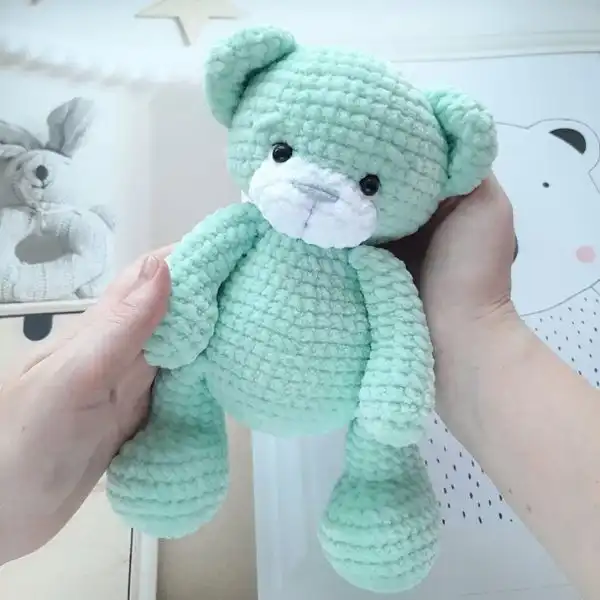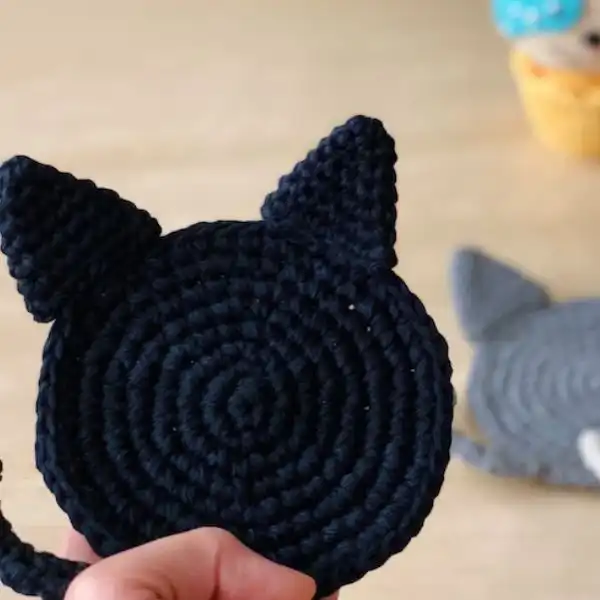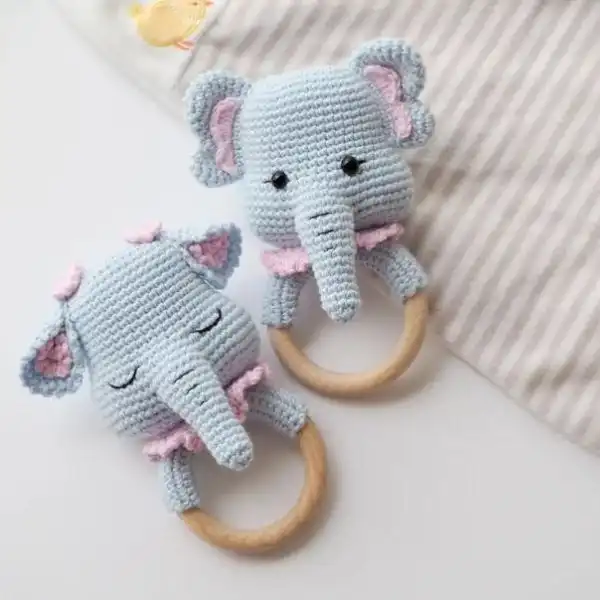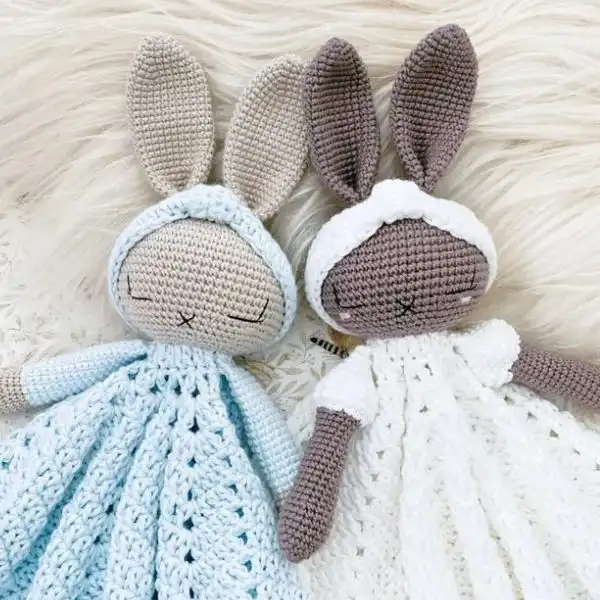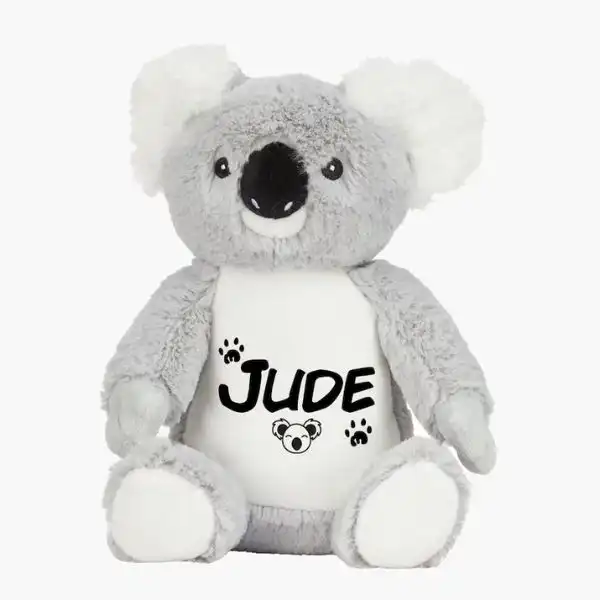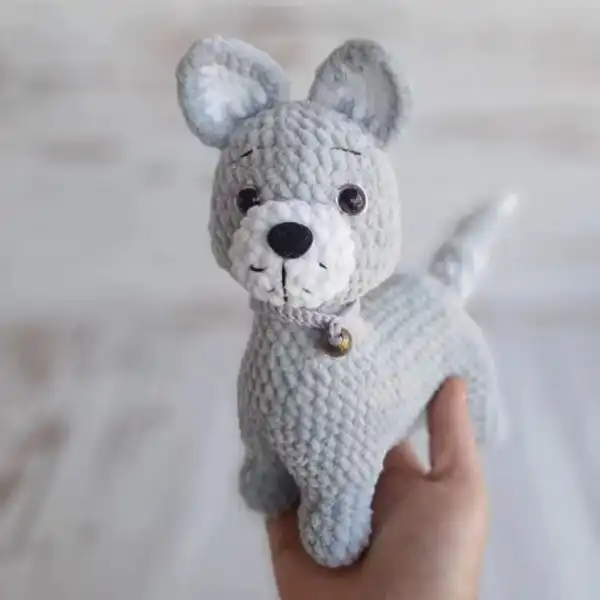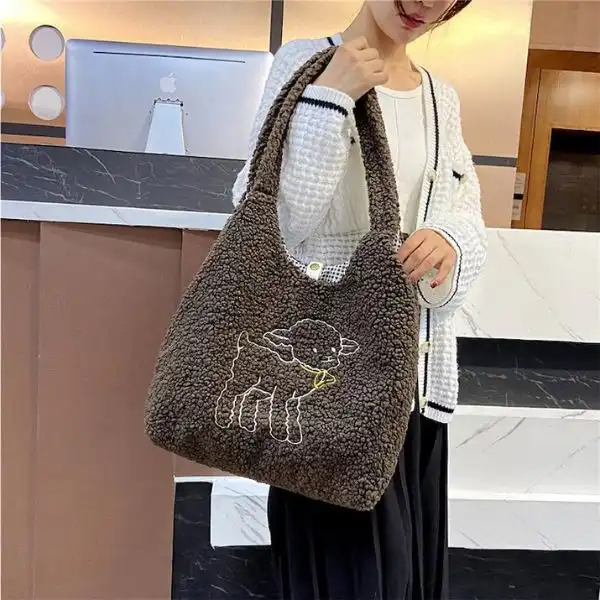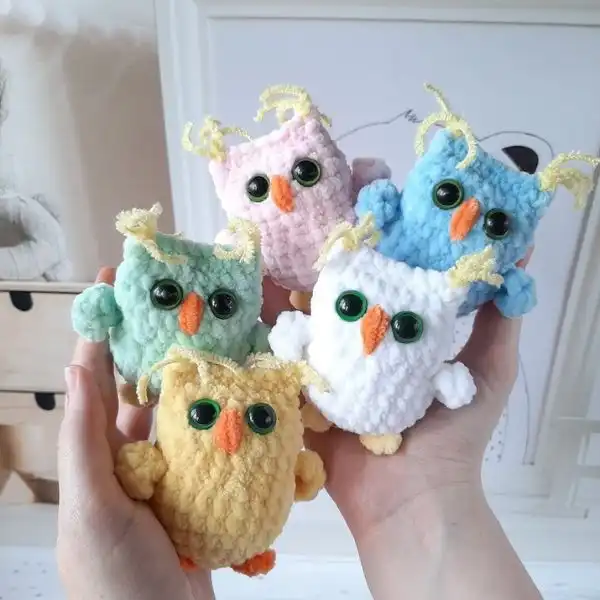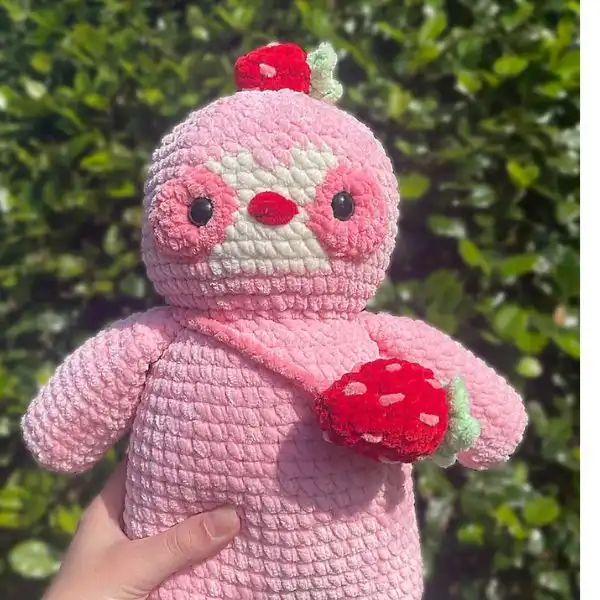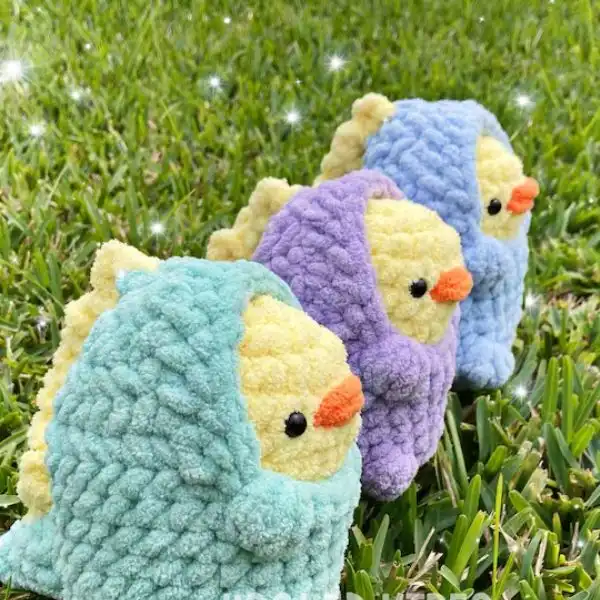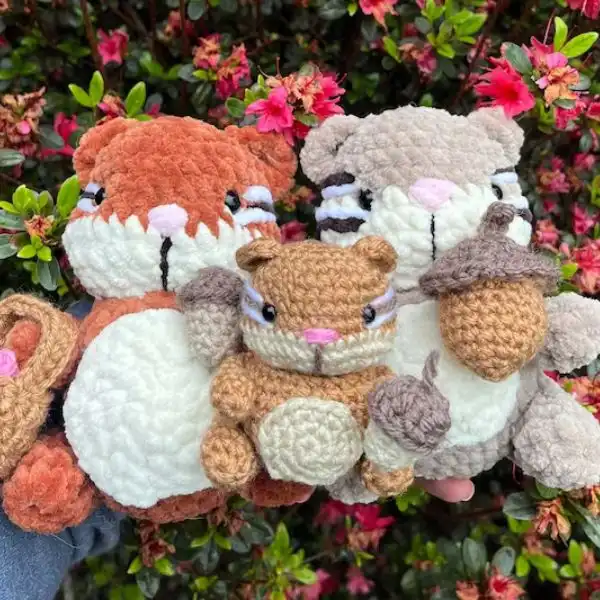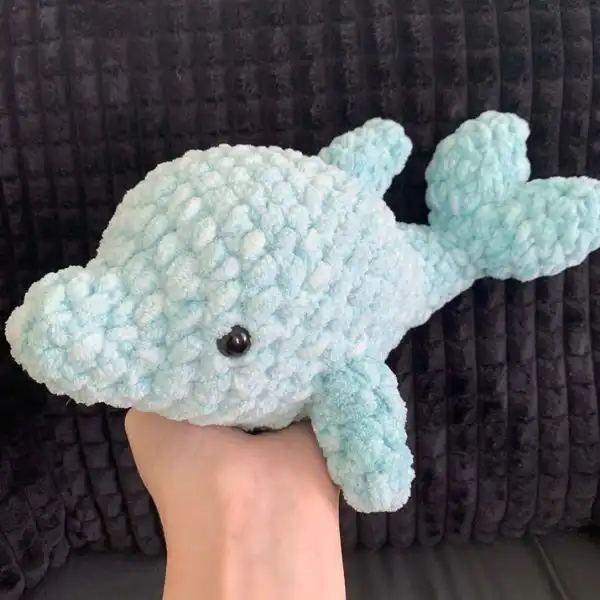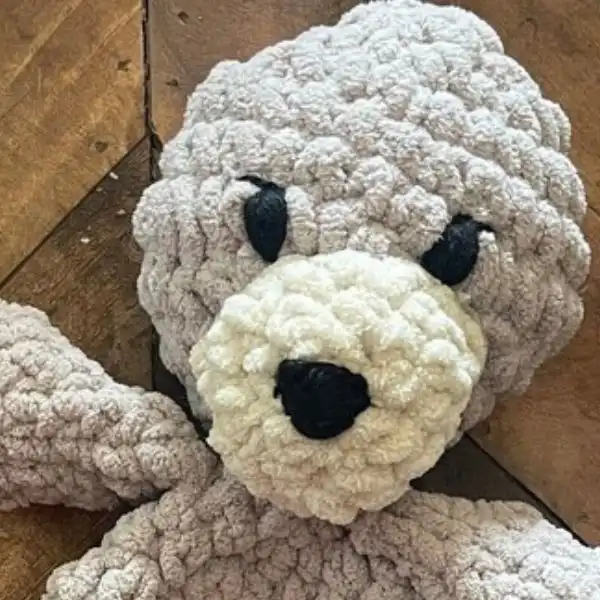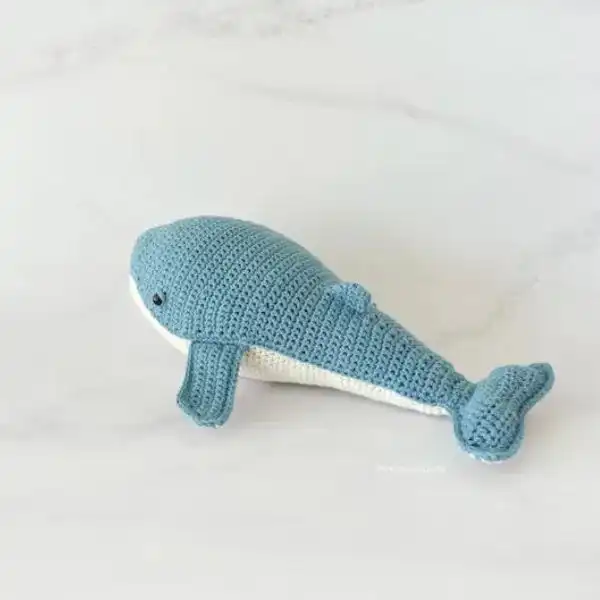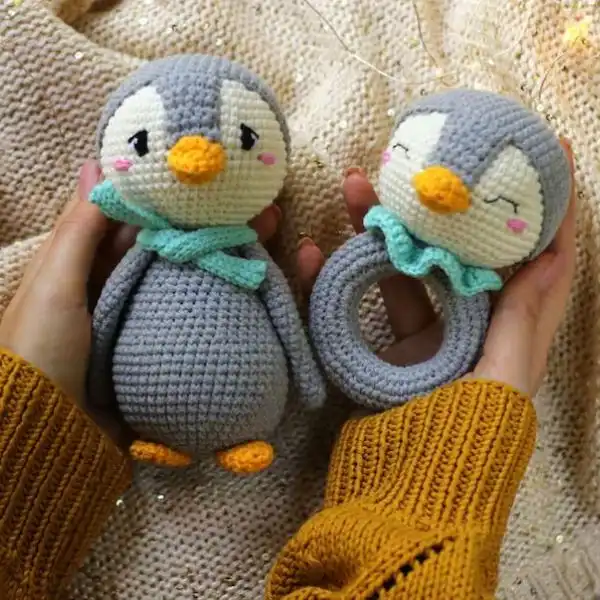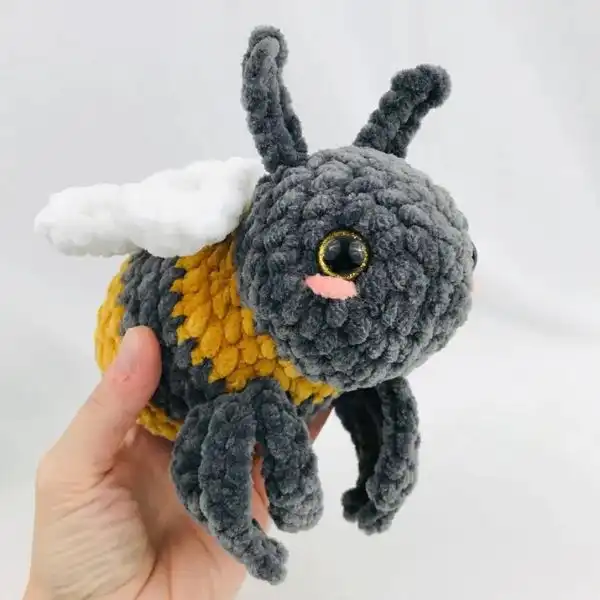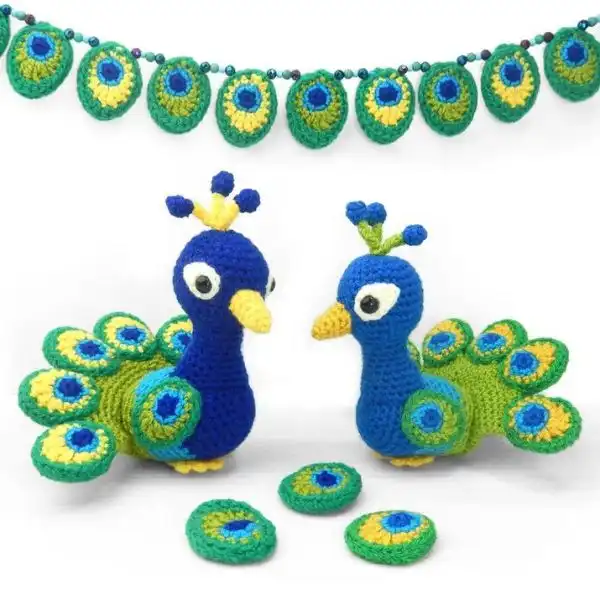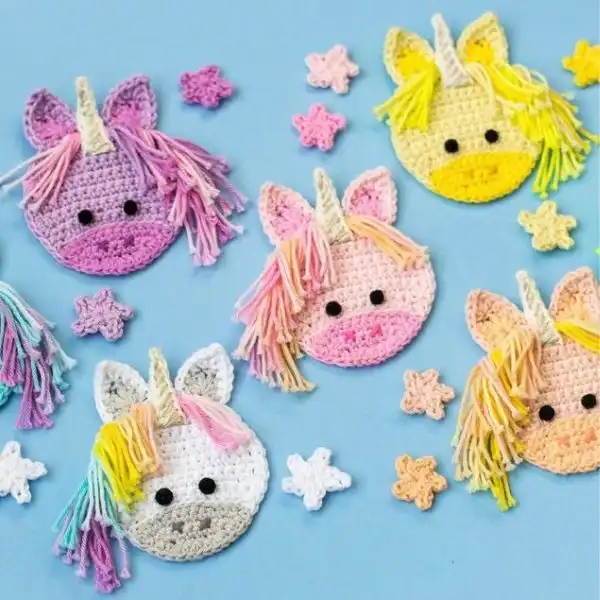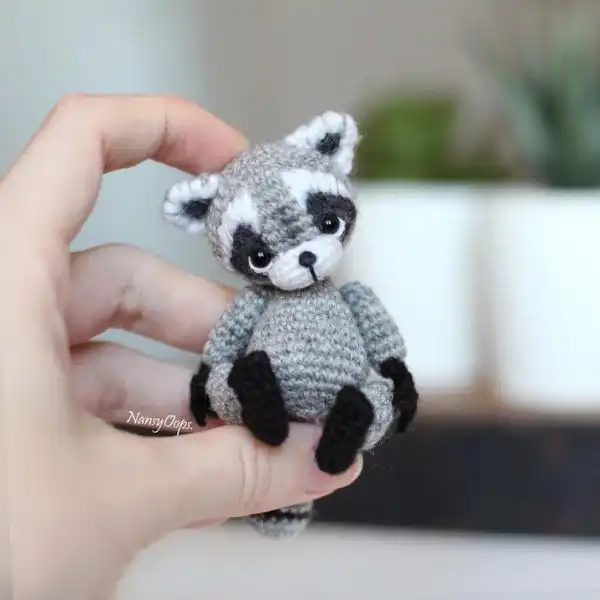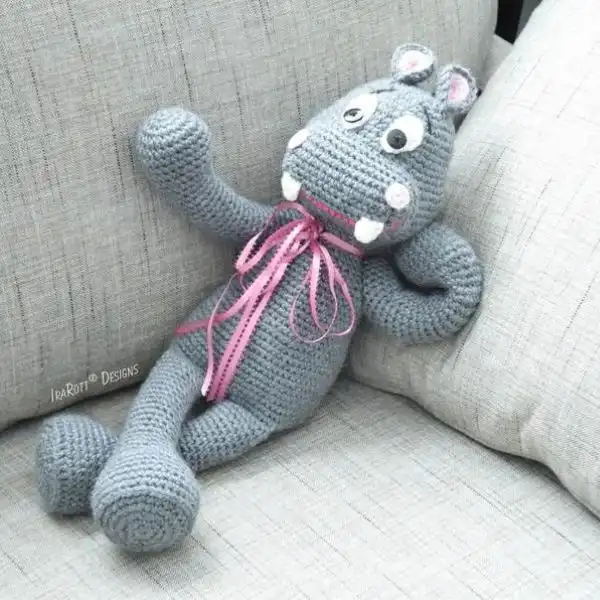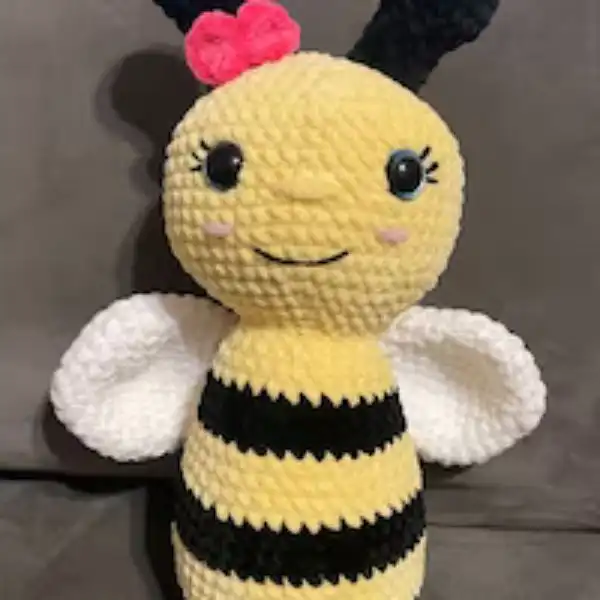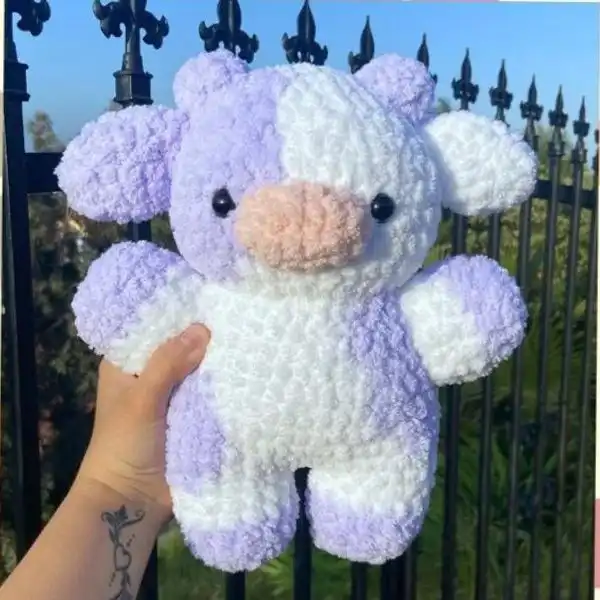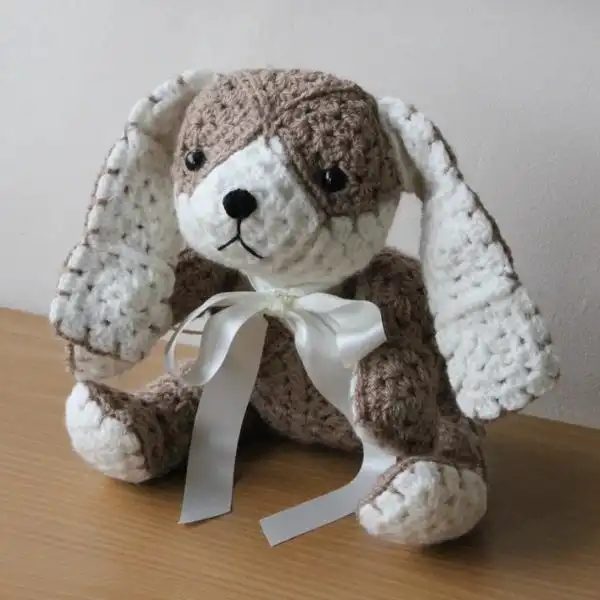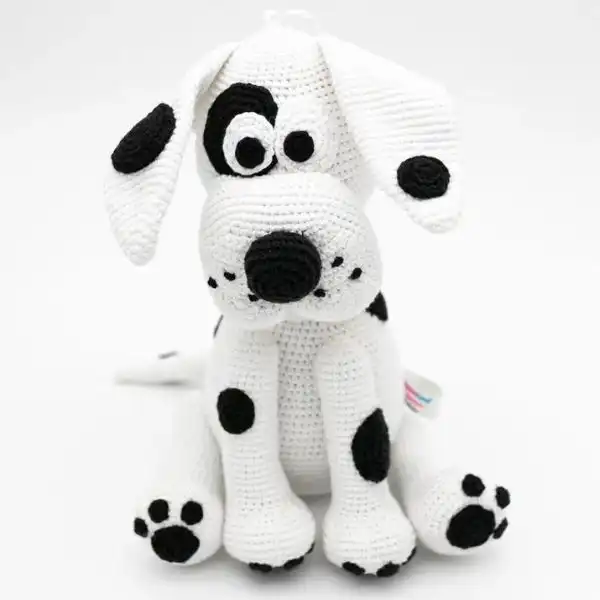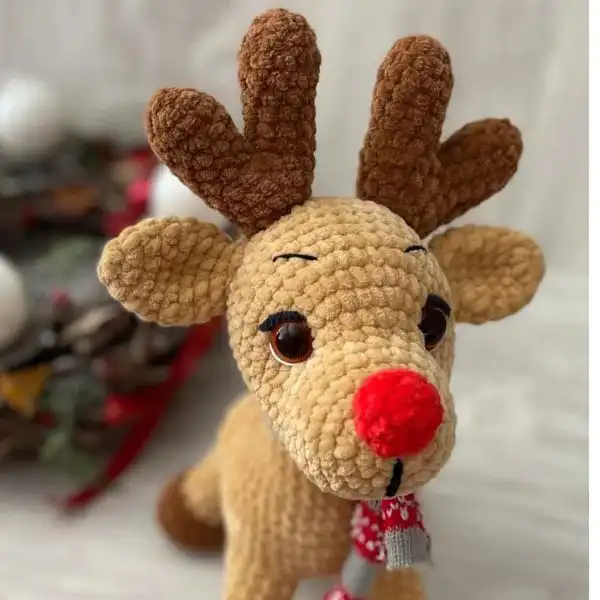Crochet animal patterns are a charming and creative way to express your love for animals and crafting. These patterns range from adorable, cuddly creatures to intricate, detailed wildlife designs, making them a perfect project for beginners and seasoned crocheters.

These patterns can be a source of joy, as the end products often make wonderful toys for children, decorative pieces, or sentimental gifts for loved ones.
From the simplicity of a bunny to the complexity of a peacock, crochet animal patterns invite us to bring a bit of nature’s whimsy into our homes.
Through the world of crochet animal patterns, you can explore different types of yarn, techniques, and stitches while learning about various animals.
This unique blend of education, artistry, and craft offers endless opportunities to create and learn.
At the same time, the end product often holds a high emotional value, being infused with the time, effort, and care of the creator.
Crafting these animals, whether for yourself or as a gift, adds a personal touch to each creation that makes it uniquely yours.
So, grab your crochet hook and dive into this beautiful, crafty world of crochet animal patterns!
Overview For The Popularity Of Amigurumi Toys
Amigurumi, the Japanese art of knitting or crocheting small, stuffed yarn creatures, has grown in popularity worldwide.
Its charming aesthetic, versatility, and endless creative possibilities have endeared it to crafters of all ages and skill levels.
Amigurumi has been adapted to create pop culture characters, fantasy creatures, and a myriad of other imaginative creations, not just restricted to traditional toy designs, making it a trending form of self-expression in the crafting community.
The handmade nature of these toys adds a unique, personalized touch that resonates with those seeking a more meaningful, mindful alternative to mass-produced toys.
The online community surrounding amigurumi has fostered a spirit of sharing, learning, and camaraderie, contributing to its widespread popularity and enduring appeal.
Essential Tools & Materials
Crochet Hooks: Various sizes may be necessary depending on the weight of your yarn and the desired tightness of your stitches.
Yarn: Comes in various weights, materials, and colors. For amigurumi, cotton or acrylic yarns are often used due to their durability.
Stitch Markers: Essential for marking the beginning and end of rounds or important stitch placements.
Stuffing Material: Polyester fiber fill is the most common, but cotton batting, wool, or fabric scraps can be used.
Yarn Needle: A large-eye blunt needle is necessary for sewing parts together and weaving in ends.
Scissors: A good pair of sharp scissors is essential for cutting yarn.
Safety Eyes: These provide a professional finish to your amigurumi animals, though they can also be embroidered.
Embroidery Floss: For adding details such as facial features or patterns.
Patterns: A written guide to create your amigurumi creature. It can be purchased or found free online.
Ruler or Measuring Tape: To check the size of your work and maintain consistency.
Row Counter: Helps keep track of rows or rounds, especially for larger projects.
Hook Case or Organizer: This keeps your tools together and is easy to find.
Stitch Guides: Useful for beginners learning new stitch techniques.
Light-up Crochet Hooks: Useful for working with dark-colored yarns or in low light conditions.
Measuring Tape: This will come in handy when you need to check the gauge of your stitches or the dimensions of your work.
Glossary Of Common Crochet Stitches And Techniques
- Chain (ch): The most basic crochet stitch used to start most projects.
- Slip Stitch (sl st): A stitch used to join work, move yarn across groups of stitches, or finish a project.
- Single Crochet (sc): A basic stitch that is shorter and more compact, often used in amigurumi for a tight weave that keeps stuffing in.
- Half Double Crochet (dc): A stitch in height between a single crochet and a double crochet.
- Double Crochet (dc): A common stitch twice as tall as a single crochet.
- Treble Crochet (tr): A tall stitch made with two yarn overs at the beginning.
- Magic Circle (MC): A technique for starting projects in the round. It is often used in amigurumi to create the head or body.
- Increase (inc): A technique where two or more stitches are made in the same Stitch to widen the piece.
- Decrease (dec): A technique where two stitches are combined into one to narrow the piece.
- Fasten Off (FO): Securing the last Stitch and cutting the yarn to finish a project.
- Invisible Decrease (inv dec): A technique used in amigurumi to reduce the number of stitches in a round without leaving a gap.
- Yarn Over (YO): Wrapping the yarn over your crochet hook.
- Back Loop Only (BLO): Insert the hook into only one loop (the one farthest from you) of the Stitch, leaving a ridge on the front of the piece.
- Front Loop Only (FLO): Insert the hook into only one loop (closest to you) of the Stitch.
- Joining with a Slip Stitch (ss): Often used to join the end of a round to the beginning, to create a seamless circle.
- Working in the Round: Crocheting in a spiral, often used in amigurumi, to create a three-dimensional shape.
- Gauge: A sample swatch to determine the size of your stitches. Important to ensure the finished project is the correct size.

Understanding Crochet Stitches & Techniques
Understanding crochet stitches and techniques involves both theoretical knowledge and hands-on practice. Here are some steps to help you get started:
- Learn Basic Terminology: Start with understanding basic crochet terms like chain (ch), slip stitch (sl st), single crochet (sc), double crochet (dc), etc. Also, familiarize yourself with terms used to describe techniques, such as increase (inc), decrease (dec), yarn over (yo), fasten off (FO), and so on.
- Understand Crochet Diagrams and Patterns: Crochet diagrams use symbols to represent different stitches and are a visual way to describe a pattern. Each character corresponds to a specific stitch. On the other hand, habits often use abbreviations of stitches and techniques. It’s essential to understand how to read these diagrams and patterns.
- Watch Video Tutorials: Video tutorials are great resources for learning crochet stitches and techniques. They allow you to see the stitch being made in real-time, which can help you understand the process more clearly. Websites like YouTube have thousands of such tutorials.
- Practice Basic Stitches: Start with the basics, like the chain stitch, slip Stitch, single crochet, and double crochet. Practice these until you’re comfortable before moving on to more complex stitches.
- Use Stitch Markers: These are great tools for beginners to mark the beginning and end of rows or rounds or where increases or decreases should be made.
- Join a Crochet Community: Online communities or local craft groups can provide knowledge and support. You can share your progress, ask questions, and learn from more experienced members.
- Practice Regularly: Like any other skill, regular practice is key. As you practice, you will understand how different stitches create different textures and shapes and how changes in techniques can affect the outcome of your project.
- Be Patient: Learning to crochet takes time and patience. Don’t be discouraged if you make mistakes. Instead, use them as a learning opportunity. With time and practice, you’ll be able to understand and execute a wide range of crochet stitches and techniques.
Which Yarn Is Best For Crochet Animal Patterns?
The type of yarn you choose for crochet animal patterns, or amigurumi, can greatly impact the final result of your project. There are several factors to consider when selecting yarn:
- Fiber Type: Acrylic and cotton yarns are commonly used for amigurumi because they’re durable, washable, and hold their shape well. Acrylic yarn is softer and more affordable, while cotton yarn gives a smoother finish and a more defined stitch definition.
- Yarn Weight: Light to medium weight yarn (DK to worsted) is commonly used for amigurumi. These weights are thick enough to give substance to your creation but not so thick that they make the project bulky or hard to handle.
- Color and Texture: The color and texture of your yarn can bring your crochet animals to life. Choose colors that match your animal’s real-life counterpart, or go creative with fantasy colors. Smooth, non-fuzzy threads are usually best for amigurumi as they give a clear stitch definition.
- Consistency: It’s important to use yarns of a similar weight and fiber type throughout a single project to ensure consistency in size and appearance. Mixing fibers or weights can lead to uneven results.
How Much Yarn Do I Need To Crochet An Animal?
The amount of yarn you’ll need to crochet an animal can vary greatly depending on several factors:
- Pattern: The pattern you’re using should give an estimate of how much yarn you’ll need. Always check the pattern first, as this will give you the most accurate estimate.
- Yarn Weight: Different yarn weights yield different yardage per gram. Lighter-weight yarns like sport or DK will go farther than heavier-weight yarns like worsted or bulky; for a small to medium-sized amigurumi, a skein of worsted-weight yarn (roughly 200-220 yards) is often enough.
- Hook Size: The size of your crochet hook can affect how much yarn you use. A larger angle will use more thread than a smaller one.
- Stitch: The type of Stitch you’re using can also impact the amount of yarn used. More complex stitches tend to use more thread than simpler ones.
- Size of the Project: Larger projects require more yarn. If you’re making a large amigurumi, you’ll need more yarn than if you’re making a smaller one.
As a rough estimate for small to medium-sized amigurumi animals, you need between 100-200 yards of yarn.
However, this is a general approximation, and the actual amount can vary. For large or intricate animals, you may need several hundred yards.
When buying yarn for a project, overestimating your needs is always better. That way, you’ll have enough and avoid running out partway through.
Plus, any leftover yarn can be used for future projects or crafting smaller items, like accessories for your amigurumi animals.

Is It Beginner Friendly?
Crocheting amigurumi, or crochet animal patterns, can be beginner-friendly, but it often depends on the complexity of the way. Some designs are relatively simple and make a great starting point for beginners.
These patterns often involve creating basic shapes such as spheres, cylinders, and cones, which are joined together to create an animal.
The stitches used are typically simple, including single crochet, slip stitch, and the basic increasing and decreasing techniques.
However, some amigurumi patterns can be complex and involve intricate shaping, color changes, and advanced stitches. As such, they might be more suitable for intermediate or advanced crocheters.
As a beginner, you can get started with amigurumi. Here are some tips to make it easier:
- Start with a Simple Pattern: Choose a pattern for beginners. These are often smaller and involve fewer complicated techniques.
- Learn the Basics: Before starting an amigurumi project, you are comfortable with the basic crochet stitches (like single crochet) and techniques (like increasing and decreasing).
- Practice: Practice makes perfect. Start by making small, simple shapes and gradually work up to more complex projects.
- Use Helpful Tools: Tools like stitch markers can be handy when working in the round, as they can help you keep track of where your bands start and end.
- Be Patient: Learning to crochet amigurumi can take time. Don’t rush it; don’t be too hard on yourself if your first few attempts don’t turn out perfectly.
Different Types Of Crochet Animals
1. Amigurumi Teddy Bear
Amigurumi refers to the art of crocheting or knitting stuffed toys. An amigurumi teddy bear is a cute and cuddly crocheted teddy bear, typically made with soft yarn and stuffed to create a plush toy.
Suggested Yarn: Red Heart Super Saver - Acrylic
Difficulty Level: Intermediate
Yarn Weight: Worsted
Crochet Hook: 4.00mm
2. Cute Cat Coaster
A cute cat coaster is a small crochet project in the shape of a cat’s face or silhouette. It is designed to be placed under a drink to protect surfaces while adding a touch of charm to your home decor.
3. Baby Elephant Rattle
A baby elephant rattle is a crocheted toy designed for infants. It usually has a round body with an elephant face and a small handle or attachment that rattles when shaken, providing sensory stimulation and entertainment for babies.
Suggested Yarn: Yarn Home Bamboo Yarn
Difficulty Level: Intermediate
Yarn Weight: Sport
Crochet Hook: 4.50mm
4. Little Bunny Lovey
A little bunny lovey combines a stuffed animal and a small blanket. It typically features a crochet bunny head and arms attached to a soft and cozy blanket, providing comfort and companionship for infants and young children.
5. Cuddly Koala
A cuddly koala is a crocheted toy resembling a koala bear. It is often made with fuzzy or textured yarn to mimic the koala’s fur and features a cute face, rounded body, and sometimes movable limbs.
6. Playful Puppy
A playful puppy is a crocheted toy shaped like a dog or puppy. It can be made in various sizes and styles, with details like floppy ears, a tail, and a friendly face, making it an adorable companion for children or dog lovers.
7. Fluffy Lamb
A fluffy lamb is a crocheted toy that resembles a lamb or sheep. It is usually made with soft and smooth yarn to mimic the lamb’s wool, and it often has a round body, cute facial features, and floppy ears.
8. Adorable Owl Keychain
An adorable owl keychain is a small crocheted owl toy attached to a keychain. It is a decorative accessory for keys and a cute, portable companion.
9. Sleepy Sloth
A sleepy sloth is a crocheted toy that depicts a sloth known for its slow and relaxed nature. It often has long arms and legs and a tired expression, making it a charming and huggable creature.
Suggested Yarn: Windrush Brunswick Vintage Yarn Acrylic
Difficulty Level: Intermediate
Yarn Weight: Worsted
Crochet Hook: 4.50mm
RELATED: Easy Crochet Bookmark: Perfect Project for Beginners
10. Sweet Squirrel
An adorable squirrel is a crocheted toy inspired by a squirrel. It typically has a bushy tail, rounded body, and cute facial features, capturing the charm of these woodland creatures in a crochet creation.
11. Charming Chick
A lovely chick is a crocheted toy resembling a baby chicken. It features a round body, tiny wings, and a cute beak and eyes, capturing the adorable essence of these little birds.
Suggested Yarn: Lily Sugar N Cream Cones Cotton Yarn
Difficulty Level: Intermediate
Yarn Weight: Sport
Crochet Hook: 3.50mm
12. Tiny Turtle
A little turtle is a crocheted toy inspired by a turtle. It typically has a shell, four legs, and a small head, replicating the unique appearance of a turtle in a miniature form.
13. Silly Monkey
A silly monkey is a crocheted toy depicting a mischievous monkey. It often has long arms, a curly tail, and a cheerful expression, capturing monkeys’ lively and animated nature.
Suggested Yarn: Lion Brand Truboo 145 Mauve Bamboo Yarn
Difficulty Level: Intermediate
Yarn Weight: Worsted
Crochet Hook: 4.50mm
14. Lovely Ladybug
An adorable ladybug is a crocheted toy shaped like a ladybug. It usually has a round body, colorful spots, and cute antennae, representing ladybugs’ charming and gentle nature.
Suggested Yarn: Sisipal 2200 Acrylic Yarn
Difficulty Level: Easy
Yarn Weight: Sport
Crochet Hook: 3.00mm
RELATED: 35 Sock Knitting Patterns To Inspire You For Mastering The Art
15. Happy Hedgehog
A happy hedgehog is a crocheted toy resembling a hedgehog. It typically has a spiky back, a small snout, and a cheerful expression, capturing hedgehogs’ adorable and friendly nature.
16. Cheeky Chipmunk
A cheeky chipmunk is a crocheted toy inspired by a chipmunk. It often has a round body, striped patterns, and a mischievous expression, reflecting chipmunks’ playful and lively characteristics.
Suggested Yarn: Mira HandCrafts Acrylic Yarn
Difficulty Level: Easy
Yarn Type: Acrylic
Crochet Hook: 4.00mm
17. Delightful Dolphin
A lovely dolphin is a crocheted toy resembling a dolphin. It typically has a sleek body, a dorsal fin, and a friendly face, capturing the grace and elegance of these intelligent marine creatures.
Suggested Yarn: CraftBud Acrylic Yarn
Difficulty Level: Intermediate
Yarn Weight: Sport
Crochet Hook: 3.50mm
18. Graceful Giraffe
A graceful giraffe is a crocheted toy depicting a giraffe. It usually has a long neck, patterned spots, and a kind expression, representing giraffes’ majestic and gentle nature.
Suggested Yarn: Lily Sugar 'n Cream Cotton Yarn
Difficulty Level: Easy
Yarn Weight: DK
Crochet Hook: 4.00mm
19. Snuggly Seal
A snuggly seal is a crocheted toy inspired by a seal. It typically has a round body, flippers, and a sweet face, capturing seals’ endearing and cuddly qualities.
Suggested Yarn: Studio Sam Acrylic Yarn
Difficulty Level: Intermediate
Yarn Weight: Worsted
Crochet Hook: 4.50mm
20. Whimsical Whale
A whimsical whale is a crocheted toy resembling a whale. It often has a curved body, a spout, and a smiling face, representing these majestic ocean creatures’ enchanting and magical nature.
21. Playful Penguin
An animated penguin is a crocheted toy resembling a penguin. It typically has a round body, flippers, and a distinctive beak, capturing these aquatic birds’ lively and adorable nature.
22. Dainty Deer
A delicate deer is a crocheted toy inspired by a deer. It often has slender legs, antlers, and a gentle expression, reflecting the elegance and grace of these majestic forest animals.
Suggested Yarn: Alize Diva Acrylic yarn
Difficulty Level: Easy
Yarn Weight: Worsted
Crochet Hook: 4.00mm
23. Friendly Fox
A friendly fox is a crocheted toy depicting a fox. It typically has a bushy tail, pointy ears, and a curious expression, capturing foxes’ clever and playful nature.
Suggested Yarn: Paintbox Yarns Simply DK - Acrylic Yarn
Difficulty Level: Intermediate
Yarn Weight: Sport
Crochet Hook: 3.50mm
24. Busy Bee
A busy bee is a crocheted toy resembling a bee. It often has a striped body, wings, and a friendly face, representing bees’ industrious and buzzing nature.
Suggested Yarn: JubileeYarn Cotton Select Yarn
Difficulty Level: Easy
Yarn Weight: DK
Crochet Hook: 4.00mm
25. Pretty Peacock
A pretty peacock is a crocheted toy inspired by a peacock. It typically has a beautiful tail with colorful feathers, a regal stance, and a stunning appearance, capturing the magnificence of peacocks.
Suggested Yarn: Pomaret Acrylic yarn
Difficulty Level: Intermediate
Yarn Weight: Sport
Crochet Hook: 3.50mm
26. Magical Unicorn
A magical unicorn is a crocheted toy resembling a unicorn. It often has a horn, a flowing mane, and a serene expression, representing unicorns’ enchanting and mythical nature.
27. Brave Lion
A brave lion is a crocheted toy depicting a lion. It typically has a majestic mane, a strong stance, and a confident expression, symbolizing the courage and strength of lions.
Suggested Yarn: Gazzal Baby Cotton Yarn
Difficulty Level: Intermediate
Yarn Weight: DK
Crochet Hook: 3.75mm
28. Wiggly Worm
A wiggly worm is a crocheted toy inspired by a worm. It usually has a long, curvy body and a friendly face, capturing worms’ whimsical and wriggling nature.
Suggested Yarn: I Love This Yarn - Acrylic
Difficulty Level: Easy
Yarn Weight: Worsted
Crochet Hook: 4.00mm
29. Fluttering Butterfly
A fluttering butterfly is a crocheted toy resembling a butterfly. It often has colorful wings, delicate antennas, and a graceful appearance, symbolizing the beauty and freedom of butterflies.
Suggested Yarn: Yinsun Acrylic Yarn
Difficulty Level: Intermediate
Yarn Weight: Sport
Crochet Hook: 3.50mm
30. Curious Raccoon
A curious raccoon is a crocheted toy depicting a raccoon. It typically has a masked face, ringed tail, and a curious expression, reflecting raccoons’ playful and inquisitive nature.
Suggested Yarn: Lion Brand 24/7 Cotton Yarn
Difficulty Level: Easy
Yarn Weight: DK
Crochet Hook: 4.00mm
31. Sassy Snake
A sassy snake is a crocheted toy resembling a snake. It typically has a long, curvy body, a flicking tongue, and a playful expression, capturing the snake’s unique and slithery nature.
Suggested Yarn: Mainstays Medium Acrylic Yarn
Difficulty Level: Intermediate
Yarn Weight: Worsted
Crochet Hook: 4.5mm
32. Happy Hippo
A happy hippo is a crocheted toy inspired by a hippopotamus. It often has a round body, small ears, and a smiling face, reflecting hippos’ joyful and friendly characteristics.
33. Gentle Giraffe
A gentle giraffe is a crocheted toy depicting a giraffe. It usually has a long neck, patterned spots, and a calm expression, symbolizing giraffes’ peaceful and serene nature.
Suggested Yarn: Schachenmayr Cotton yarn
Difficulty Level: Intermediate
Yarn Weight: DK
Crochet Hook: 3.75mm
34. Cuddly Caterpillar
A cuddly caterpillar is a crocheted toy resembling a caterpillar. It typically has a segmented body, small legs, and a cute face, inviting cuddles and playfulness.
Suggested Yarn: Super Bulky Heather Acrylic Yarn
Difficulty Level: Easy
Yarn Weight: Worsted
Crochet Hook: 4.00mm
35. Energetic Elephant
An active elephant is a crocheted toy inspired by an elephant. It often has a sturdy body, large ears, and an animated expression, capturing elephants’ lively and energetic nature.
Suggested Yarn: Sears Sayelle Green Heather Acrylic Yarn
Difficulty Level: Intermediate
Yarn Weight: Worsted
Crochet Hook: 3.50mm
36. Waddling Duckling
A waddling duckling is a crocheted toy resembling a baby duck. It typically has a small round body, webbed feet, and a charming expression, portraying the adorable and clumsy waddling of ducklings.
37. Cozy Cow
A comfortable cow is a crocheted toy depicting a cow. It usually has a round body, black and white markings, and a content expression, symbolizing cows’ calm and gentle nature.
Suggested Yarn: DROPS Muskat - Cotton
Difficulty Level: Intermediate
Yarn Weight: DK
Crochet Hook: 3.75mm
38. Bouncy Bunny
A bouncy bunny is a crocheted toy inspired by a rabbit. It often has long ears, a fluffy tail, and a playful stance, capturing bunnies’ lively and energetic movements.
Suggested Yarn: Caron Simply Soft - Acrylic
Difficulty Level: Easy
Yarn Weight: Worsted
Crochet Hook: 4.00mm
39. Wise Owl
A wise owl is a crocheted toy resembling an owl. It typically has large round eyes, a pointed beak, and a thoughtful expression, symbolizing wisdom and knowledge.
Suggested Yarn: Caron Simply Soft - Acrylic
Difficulty Level: Intermediate
Yarn Weight: Sport
Crochet Hook: 3.50mm
40. Jumping Frog
A jumping frog is a crocheted toy resembling a frog. It often has a springy body, long limbs, and a cheerful face, representing frogs’ playful and hopping nature.
41. Dashing Dalmatian
A dashing Dalmatian is a crocheted toy inspired by a Dalmatian dog. It typically has a spotty pattern, floppy ears, and an alert expression, capturing Dalmatians’ lively and energetic nature.
Suggested Yarn: Caron Simply Soft - Acrylic
Difficulty Level: Intermediate
Yarn Weight: Worsted
Crochet Hook: 4.00mm
42. Mischievous Mouse
A bad mouse is a crocheted toy resembling a playful mouse. It often has round ears, a long tail, and a curious expression, reflecting mice’s agile and inquisitive nature.
43. Spiky Hedgehog
A spiky hedgehog is a crocheted toy depicting a hedgehog. It typically has a textured body, prickly spines, and a sweet face, representing hedgehogs’ unique and charming characteristics.
Suggested Yarn: DROPS PARIS - Cotton
Difficulty Level: Intermediate
Yarn Weight: DK
Crochet Hook: 3.75mm
RELATED: 25 Useful Paracord Lanyard Patterns (Including Pictures)
44. Regal Reindeer
A regal reindeer is a crocheted toy inspired by a reindeer. It often has majestic antlers, a proud stance, and a serene expression, symbolizing the grace and beauty of reindeer.
Suggested Yarn: Caron Simply Soft Yarn - Acrylic
Difficulty Level: Easy
Yarn Weight: Worsted
Crochet Hook: 4.00mm
45. Prancing Pony
A prancing pony is a crocheted toy resembling a small horse or pony. It typically has a flowing mane, a spirited stance, and a lively expression, capturing ponies’ energetic and playful nature.
Suggested Yarn: Teal Yarn - Acrylic
Difficulty Level: Intermediate
Yarn Weight: Sport
Crochet Hook: 3.50mm
Tips To Avoid Crochet Mistakes
As with any craft, mistakes in crochet are common, especially for beginners. However, with some tips and tricks, you can minimize these errors and improve the quality of your work:
- Read the Entire Pattern Before Starting: This gives you an overview of what to expect and helps you understand the project’s progression.
- Use Stitch Markers: They are accommodating for keeping track of your rounds or rows, particularly in amigurumi, where it can be easy to lose your place.
- Count Your Stitches: Regularly count your stitches to ensure you have the correct number. It can prevent you from accidentally increasing or decreasing.
- Maintain Even Tension: Uneven tension can lead to irregular stitches and a finished product that needs to hold its shape better. Practice makes perfect, so keep working on keeping your yarn tension consistent.
- Use the Correct Hook Size: The hook size can greatly affect the outcome of your project. A too-big hook can result in a loose, floppy fabric, while a too-small theme can create a stiff material.
- Learn How to Fix Mistakes: Everyone makes mistakes, but correcting them is important. Whether it’s learning to unravel your work (also known as “frogging”) or fixing a dropped stitch, plenty of online tutorials guide you.
- Take Breaks: Taking regular breaks can prevent fatigue and reduce the likelihood of making mistakes if you’re working on a complex pattern or a large project.
- Don’t Rush: Crochet is a craft to be enjoyed. Take your time with each Stitch, and remember that slower, more careful work often results in fewer mistakes.
- Join a Community: Joining a crochet community online or in person can be incredibly helpful. More experienced crocheters can provide advice and solutions to common mistakes.
- Practice Regularly: The more you crochet, the better you’ll get at it. Over time, you’ll develop muscle memory and a feel for how the yarn and hook work together, which can help prevent mistakes.
How To Block The Crochet Animal?
Blocking is a process used to set the final shape and dimensions of a finished crochet or knit piece.
It is often used for flat items like blankets, shawls, and squares, but it can also be used for some amigurumi (crocheted animals). Here’s how you can do it:
Materials Needed

Steps
- Prepare Your Surface: Lay out a clean towel or foam-blocking board on a flat surface. The surface must be somewhere the piece can sit undisturbed until arid.
- Wet Your Amigurumi: Fill a spray bottle with water and lightly mist your crocheted animal until damp but not soaking. Alternatively, if your yarn is steam-blocking safe (check the yarn label), use a steam iron a few inches above the crochet item and steam until damp.
- Shape Your Amigurumi: Gently shape your amigurumi to the desired final form. For instance, you might stretch the arms out or straighten the legs. Be careful not to overstretch any parts, as they could become floppy and shapeless.
- Pin in Place: Use rust-proof pins to hold your amigurumi in the desired shape. Push the pins in at various points to have the form. The nails must be rust-proof to avoid rust staining your work when wet.
- Let it Dry: Allow your amigurumi to dry completely. It can take several hours to a couple of days, depending on the thickness of the yarn and the humidity of the environment.
- Unpin and Enjoy: Carefully remove all the pins once completely dry. Your amigurumi should hold its new shape.
While blocking can help refine the shape of an amigurumi, the nature of stuffed items means they might not require stopping as often as other crochet projects.
It’s also worth noting that not all yarn types respond well to blocking, so it’s important to always check the yarn label.
Suggestions For Adding Personal Touch
Adding a personal touch to your crochet animal patterns not only makes them unique but also adds a special meaning to your work. Here are some suggestions:
- Color Choice: Customize your crochet animals with your or the recipient’s favorite colors. Refrain from natural animal colors; vibrant hues can add a fun and whimsical touch!
- Embellishments: Add beads, sequins, ribbons, bows, or buttons for extra decoration. These can be especially fun for creating unique facial expressions or adding clothes and accessories to your crochet animals.
- Yarn Texture: Experiment with different types of yarn for other effects. For example, fuzzy yarn could give the appearance of fur, while sparkly yarn could make a magical creature truly enchanting.
- Stitch Variation: Try using different stitches to create interesting patterns and textures on your crochet animals. It could be as simple as alternating between a few basic stitches or as complex as incorporating more intricate designs.
- Size Variation: Consider altering the size of your crochet animals for different needs. Miniature versions can make cute keychains or ornaments, while larger versions could serve as cuddly stuffed toys or even pillows.
- Name Your Creation: Give your crochet animal a special name, which could be included on a homemade tag or card if you’re giving it as a gift.
- Add a Scent: For an extra special touch, consider adding a calming scent to your crochet animals. A few drops of essential oil on the stuffing can make your creation a visual and olfactory delight.
- Personalized Tags: If you’re gifting the crochet animal, consider adding a personalized tag. You could include details like the recipient’s name, the occasion, and the date.
Wash & Care Instructions
Properly caring for and cleaning your crochet animal can help maintain its appearance and prolong its lifespan.
However, the exact care instructions can vary based on the type of yarn used and any embellishments attached to the crochet animal.
Always refer to the yarn’s care label for the most accurate information. Below are general guidelines for caring for your crochet animal:
- Spot Cleaning: Try spot cleaning first for small stains or dirt. Use a mild detergent and warm water, then gently rub the stained area. A rail or toothbrush can be useful for this. Rinse with cool water and gently squeeze (don’t wring) the excess water out.
- Hand Washing: Hand washing is usually safest for deeper cleaning or larger items. Fill a basin with cool to lukewarm water and mild detergent. Submerge the crochet animal and gently agitate the water with your hands to clean it. Renew thoroughly, then remove excess water by pressing between two towels.
- Machine Washing: Some crochet items can be machine washed, but checking the yarn label first is crucial. If machine washing is safe, place the crochet animal in a mesh laundry bag to protect it from snagging. Use the gentle cycle with cold water and mild detergent.
- Drying: Never wring out crochet items, as this can distort their shape. Instead, press out excess water between towels. Reshape the crochet animal and lay it flat on a dry towel to air dry. Avoid drying in direct sunlight, which can cause colors to fade.
- Storage: Store your crochet animals in a cool, dry place out of direct sunlight. If storing for long periods, consider placing it in a breathable fabric bag to protect it from dust.
- General Care: Regularly fluffing and reshaping your crochet animals can help them keep their shape. Avoid pulling on loose threads; carefully trim them with scissors or tuck them back in.

Advanced Crochet Techniques And Stitches
Advanced crochet techniques and stitches can add texture, visual interest, and complexity to your projects. Here are some of the more advanced techniques and stitches you might want to explore:
- Front Post and Back Post Stitches (FP/BP): These stitches are worked around the post of the Stitch from the previous row instead of into the top of the Stitch. They can create a ridged, textured fabric that’s perfect for things like cables and ribbing.
- Tunisian Crochet: This unique technique uses a long hook and combines elements of both knitting and crocheting. The fabric is dense and warm, great for blankets and winter wear.
- Broomstick Lace: This technique combines a crochet hook and a large knitting needle to create beautiful, open, lace-like stitches.
- Bavarian Square: An intricate square pattern composed of several rounds of color changes and various stitches. It’s often used in making blankets and throws.
- Bullion Stitch: A twist on the basic crochet stitch involves wrapping the yarn several times around the crochet hook to create an elongated, roll-like stitch.
- Crocodile Stitch: This Stitch creates a fabric that looks like scales or petals, and it’s often used to generate dragon or mermaid-themed items.
- Overlay Crochet: A technique where stitches of different heights are worked into previous rounds, rather than the current round, to create a multilayered, textured fabric.
- Hairpin Lace: This lace technique uses a crochet hook and a special hairpin lace loom to create delicate, looped strips that are joined together.
- Solomon’s Knot (or Lover’s Knot): This Stitch creates a light, lacy fabric with a distinctive knotted appearance.
- Filet Crochet: This technique involves creating filled and open squares to create a picture or pattern within your crochet.
- Jacquard Crochet: This multi-color crochet method involves carrying the unused color(s) behind the work and switching colors as necessary.
Recommended Advanced Crochet Animal Patterns
Here are five advanced crochet animal patterns that will offer a fun and rewarding challenge for experienced crocheters.
Each one adds its unique twists, techniques, and details:
- Sophie’s Universe Elephant: This pattern incorporates the intricate design of the popular Sophie’s Universe blanket into the body of an adorable elephant. It involves various advanced techniques, including overlay crochet and intricate colorwork.
- Heidi Bears’ African Flower Motif Animals: These stunning patterns use the African flower motif to create a range of animals, from dinosaurs to elephants. Assembling the motifs into a 3D animal form is a great exercise in geometry and construction.
- ElevenHandmade’s Crocodile Stitch Owl: This pattern uses a crocodile stitch to create a textured, feather-like effect on an owl. It’s a great way to master this visually striking technique.
- Lookatwhatimade’s Amamani (Amigurumi Amish Puzzle Animals): These patterns combine amigurumi with the concept of Amish puzzle balls. Each animal is made up of three segments that can be taken apart and reassembled, providing an additional layer of fun.
- Lalylala’s Seasons series: These whimsical patterns include a range of animals, each with a seasonal theme. The designs include unique details, such as the spring lamb with a removable wooly coat, and involve various advanced techniques and stitches.
A Quick Recap
Crocheting animal patterns, also known as amigurumi, is a craft that’s suitable for beginners and advanced crafters alike. The necessary tools include crochet hooks, yarn, stitch markers, and a yarn needle.
Learning to read patterns and understand various stitches and techniques is crucial. The best thread for such projects is often acrylic or cotton due to their durability and shape retention. Care for your crochet animals includes spot cleaning and occasional washing.
Advanced crochet techniques can add uniqueness to your projects, while personal touches can give them added charm and sentiment.
Frequently Asked Questions
What Is The Best Type Of Yarn For Crocheting Animal Patterns?
Cotton and acrylic yarns are often recommended for crochet animal patterns because they are durable, washable, and hold their shape well.
I’m A Beginner. Can I Start With Crochet Animal Patterns?
There are many beginner-friendly patterns available. Start with basic shapes and stitches, then gradually move to more complex patterns as you gain confidence.
How Much Yarn Do I Need For A Crochet Animal?
The amount of yarn needed varies based on the pattern, the project’s size, and the yarn’s weight. You might need between 100-200 yards of yarn for small to medium-sized amigurumi animals.
How Do I Wash My Crochet Animal?
It depends on the yarn used. Some can be spot-cleaned or hand-washed with a mild detergent, then air-dried. Always check the care instructions for your specific yarn.
What Advanced Techniques Can I Use In Crochet Animal Patterns?
Advanced techniques such as Front Post and Back Post Stitches, Tunisian Crochet, Broomstick Lace, Crocodile Stitch, and Overlay Crochet can add texture and complexity to your crochet animal patterns. It’s always fun to learn and try new techniques!
- 25 Delightful Crochet Jellyfish Patterns For Sea Lovers - April 17, 2024
- 75 Free Lovely Crochet Sweater Patterns (With Pictures) - February 9, 2024
- 50 Free Crochet Blanket Patterns For A Cozy Home - January 22, 2024


